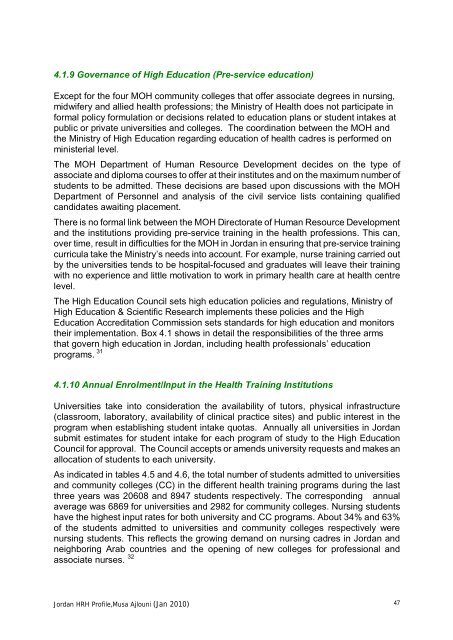Prepared by: Dr. Musa Ajlouni January, 2010 - World Health ...
Prepared by: Dr. Musa Ajlouni January, 2010 - World Health ...
Prepared by: Dr. Musa Ajlouni January, 2010 - World Health ...
You also want an ePaper? Increase the reach of your titles
YUMPU automatically turns print PDFs into web optimized ePapers that Google loves.
4.1.9 Governance of High Education (Pre-service education)Except for the four MOH community colleges that offer associate degrees in nursing,midwifery and allied health professions; the Ministry of <strong>Health</strong> does not participate informal policy formulation or decisions related to education plans or student intakes atpublic or private universities and colleges. The coordination between the MOH andthe Ministry of High Education regarding education of health cadres is performed onministerial level.The MOH Department of Human Resource Development decides on the type ofassociate and diploma courses to offer at their institutes and on the maximum number ofstudents to be admitted. These decisions are based upon discussions with the MOHDepartment of Personnel and analysis of the civil service lists containing qualifiedcandidates awaiting placement.There is no formal link between the MOH Directorate of Human Resource Developmentand the institutions providing pre-service training in the health professions. This can,over time, result in difficulties for the MOH in Jordan in ensuring that pre-service trainingcurricula take the Ministry’s needs into account. For example, nurse training carried out<strong>by</strong> the universities tends to be hospital-focused and graduates will leave their trainingwith no experience and little motivation to work in primary health care at health centrelevel.The High Education Council sets high education policies and regulations, Ministry ofHigh Education & Scientific Research implements these policies and the HighEducation Accreditation Commission sets standards for high education and monitorstheir implementation. Box 4.1 shows in detail the responsibilities of the three armsthat govern high education in Jordan, including health professionals’ educationprograms. 314.1.10 Annual Enrolment/Input in the <strong>Health</strong> Training InstitutionsUniversities take into consideration the availability of tutors, physical infrastructure(classroom, laboratory, availability of clinical practice sites) and public interest in theprogram when establishing student intake quotas. Annually all universities in Jordansubmit estimates for student intake for each program of study to the High EducationCouncil for approval. The Council accepts or amends university requests and makes anallocation of students to each university.As indicated in tables 4.5 and 4.6, the total number of students admitted to universitiesand community colleges (CC) in the different health training programs during the lastthree years was 20608 and 8947 students respectively. The corresponding annualaverage was 6869 for universities and 2982 for community colleges. Nursing studentshave the highest input rates for both university and CC programs. About 34% and 63%of the students admitted to universities and community colleges respectively werenursing students. This reflects the growing demand on nursing cadres in Jordan andneighboring Arab countries and the opening of new colleges for professional andassociate nurses. 32Jordan HRH Profile,<strong>Musa</strong> <strong>Ajlouni</strong> (Jan <strong>2010</strong>) 47

















